The tensile test (also known as a tensile strength test) is a fundamental mechanical testing procedure used to evaluate a material’s response to tensile (pulling or stretching) forces. In this test, a sample material is subjected to an axial tensile force until it fractures or fails. This procedure provides critical information about the material’s mechanical properties, which are essential for determining its suitability for specific applications.
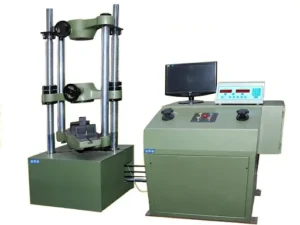
Key Parameters Measured in a Tensile Test:
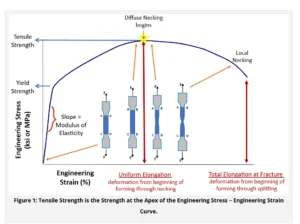
- Tensile Strength (Ultimate Tensile Strength – UTS): The maximum stress a material can withstand before it fails. It is a critical measure of the material’s ability to resist fracture under tension.
- Yield Strength: The stress at which a material begins to deform plastically. This is important for understanding the material’s ability to resist permanent deformation when subjected to loads.
- Elastic Modulus (Young’s Modulus): A measure of the material’s stiffness, representing its ability to return to its original shape after being stretched. It is the slope of the stress-strain curve in the elastic deformation region.
- Elongation (Ductility): The extent to which a material can stretch before breaking, expressed as a percentage of the original length. High elongation indicates good ductility, which is important for materials that need to undergo significant deformation before failure.
- Percentage reduction of area: How much the specimen has necked or reduced in diameter at the point of failure.
- Poisson’s Ratio: The ratio of lateral strain to axial strain. It provides insight into the material’s behavior when stretched (how much the material will shrink in width as it is pulled in length).
- Strain Hardening: The increase in stress required to continue deforming the material after it has yielded. This can be measured through the material’s stress-strain curve after the yield point.
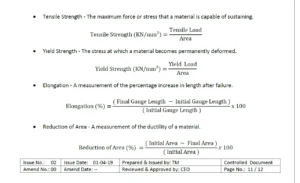
How to decide tensile test specimen size, location, and type?
There are standards like ASTM E8/E8M, ASTM A370, ISO 6892-1, IS 1608-1 etc..
We see many people get confused here. So let’s break it down in a simple way.
First, specimen size. You can use either full-size or machined specimens. Just follow what your product standard says.
Now, where to take the specimen from?
If the material is 40 mm or less in thickness, take it from the center.
If it’s more than 40 mm, take it midway between the center and surface.
Next, machining. This is a major reason for incorrect test results. So be careful during preparation.
Avoid things like burrs, notches, grooves, cold work, chatter marks, rough edges, or overheating.
Especially for brittle materials, use large-radius fillets.
Also, make sure the narrowest point is at the center of the reduced section. That helps ensure fracture happens within the gauge length.
About surface finish. If you’re testing with a surface condition other than as-manufactured, go by what your product spec says.
And yes, surface finish really matters in high strength and low ductility materials. It can affect the results.
The grip area of the specimen should be symmetrical to the centerline of the reduced section. Misalignment can cause uneven loading.
Now, let’s talk about specimen types.
Sheet-type specimen (ASTM E8/E8M, shown in Fig. 1) is used for materials like sheet, strip, flat wire, etc.
Use it when thickness is between 0.13 mm to 19 mm.
For thin or high strength materials, you might need stiffeners at the grip ends to avoid buckling.
Round specimen (ASTM E8/E8M, shown in Fig. 8) is quite common for both cast and wrought materials.
Standard size is 12.5 mm diameter.
If your material is too small for this, use a smaller proportional version.
Just make sure elongation gauge length is 4 times the diameter (as per E8) or 5 times (as per E8M).
And yes, ends should fit properly in machine grips so load stays axial.
Which one to use depends on the thickness:
0.13 to 5 mm : Use sheet-type
5 to 12.5 mm : Sheet-type or plate-type
12.5 to 19 mm : Sheet-type, plate-type, or the biggest round you can make
19 mm and above : Plate-type or the biggest round possible

ROUND TYPE SAMPLE

RECTANGULAR TYPE SAMPLE
NOTE: If your spec allows, you can also machine a modified sheet-type specimen to 10 ± 0.5 mm thick (uniform within 0.1 mm) even for 19 mm+ thickness. But if there’s any disagreement, use the round specimen as a referee.
Simple prep, proper machining, and correct size = reliable tensile test results.
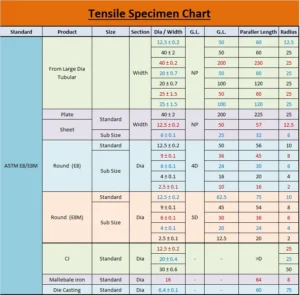
Read Also: Foundry Practice – Inoculation: Key Techniques & Benefits
Importance of Tensile Testing for Material Selection
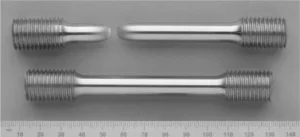
The tensile test is a critical tool for material selection, as it allows engineers and material scientists to understand how a material will behave under applied loads, particularly in tension. The test results are crucial for determining if a material is suitable for a given application, ensuring both performance and safety. Below are key reasons why tensile testing is important in material selection:
- Determining Material Strength and Durability
The tensile strength (ultimate tensile strength) provides the maximum stress a material can withstand before breaking. This is essential for selecting materials that need to resist high tensile loads without failing. For example, in structural components like beams, cables, and rods, the material’s tensile strength dictates its ability to support external loads without fracture.
- Understanding Elasticity and Stiffness
The Elastic Modulus or Young’s Modulus provides a measure of a material’s stiffness, which is essential in applications where minimal deformation is required under load. Materials with higher modulus values are stiffer and resist deformation more, making them suitable for structural applications where rigidity is important.
- Assessing Ductility and Toughness
Materials that exhibit high elongation or ductility can undergo significant deformation without breaking, which is important in applications where the material needs to absorb energy or undergo plastic deformation before failure. For example, metals like mild steel, which have high ductility, are preferred in applications like automotive crash zones, where energy absorption is critical.
- Yield Strength and Design Safety
The yield strength is critical in applications where a material will experience loads that could cause permanent deformation. For instance, in construction and aerospace industries, materials must have a high yield strength to ensure structural integrity under stress. By selecting materials with an appropriate yield strength, engineers ensure that the material will not undergo plastic deformation under typical working conditions.
- Comparing Materials for Specific Applications
Tensile testing provides a quantitative basis for comparing different materials. By evaluating multiple materials’ tensile properties, engineers can select the most appropriate material for a specific use. For example, for lightweight applications, materials with both high strength and low density, such as aluminum alloys, may be selected. Conversely, materials requiring high fracture toughness and resistance to wear, such as high-carbon steels, may be preferred for other applications.
- Predicting Performance Under Real-World Loads
Understanding the tensile properties of a material helps predict how it will behave in real-world conditions. Materials that show brittle failure (low elongation) might be unsuitable for applications where shock or impact resistance is critical, whereas those with high ductility might be selected for forming operations or applications requiring complex shapes.
- Quality Control and Standardization
Tensile testing is used as a quality control measure to ensure materials meet industry standards. Consistency in tensile properties is critical for mass production, as failure to meet the required tensile specifications can lead to component failure or substandard product performance. ISO and ASTM standards provide guidelines for tensile testing procedures to ensure that materials used in manufacturing meet necessary mechanical property requirements.
- Material Design and Optimization
Engineers use tensile testing results to optimize material properties for specific applications, ensuring that the material behaves as expected under various loading conditions. Tensile data aids in material design by helping determine factors such as:
- How much a material can stretch before failure.
- Whether it will break suddenly or exhibit gradual deformation.
- The maximum load a structure or component can bear without permanent deformation or failure.
- Conclusion

In conclusion, the tensile test is an essential tool in evaluating the mechanical properties of materials and determining their suitability for a wide range of applications. By providing critical data such as tensile strength, yield strength, elongation, and elastic modulus, tensile testing helps engineers make informed decisions about material selection. This ensures that materials are both fit for their intended purpose and meet safety, performance, and durability standards. Therefore, understanding the results of a tensile test is important for designing reliable, efficient, and safe components and structures across various industries.
Read Also: Graphite Morphology: Key Insights for Material Science
- Does your product meet tensile requirements…?
- Discuss with our team member for your product solution…
